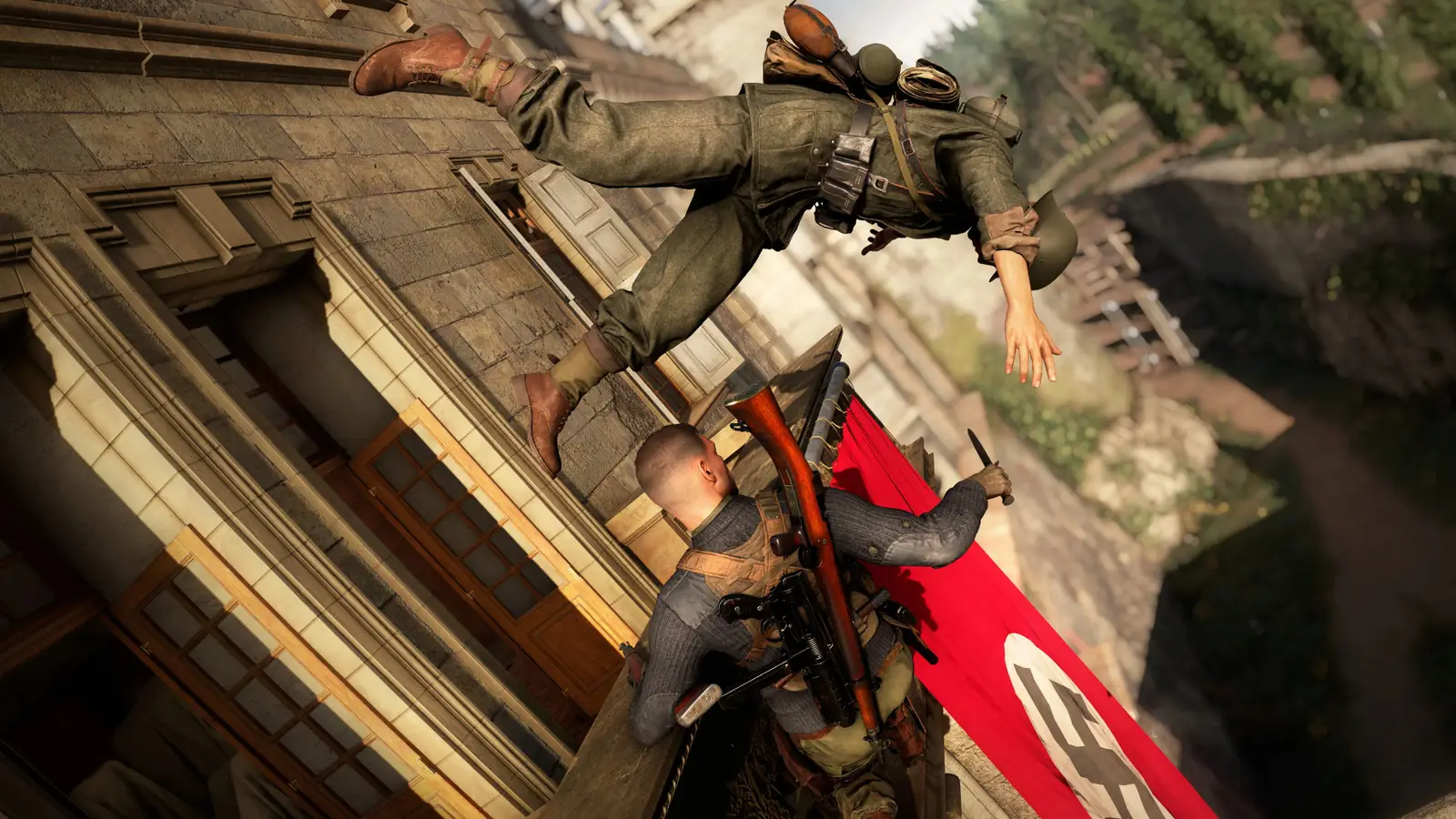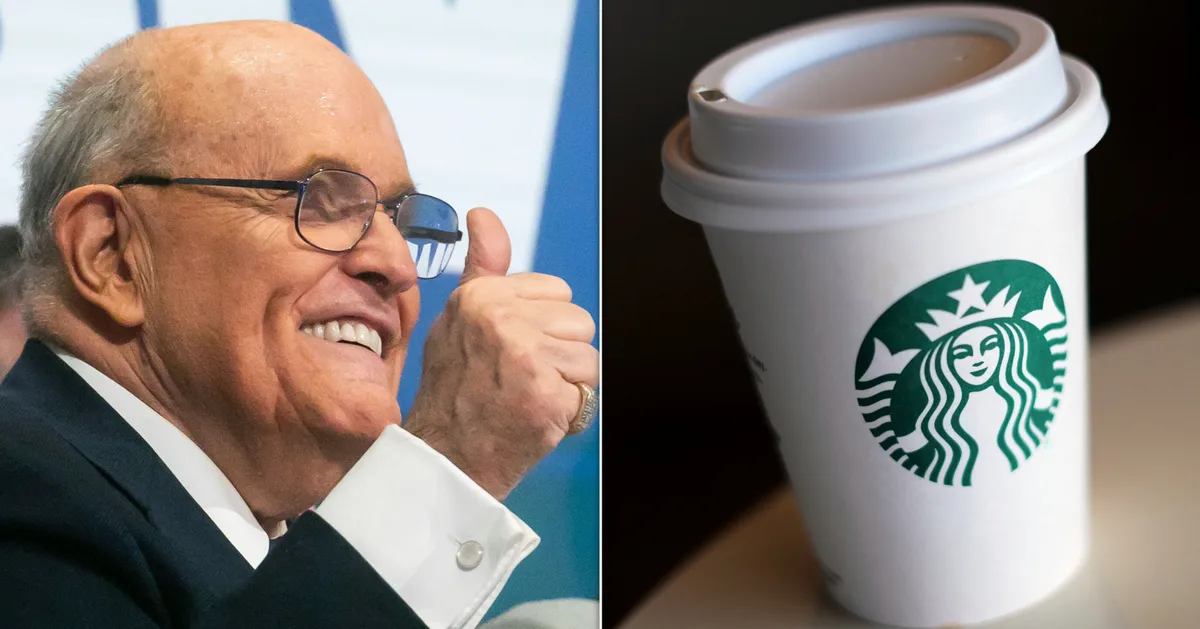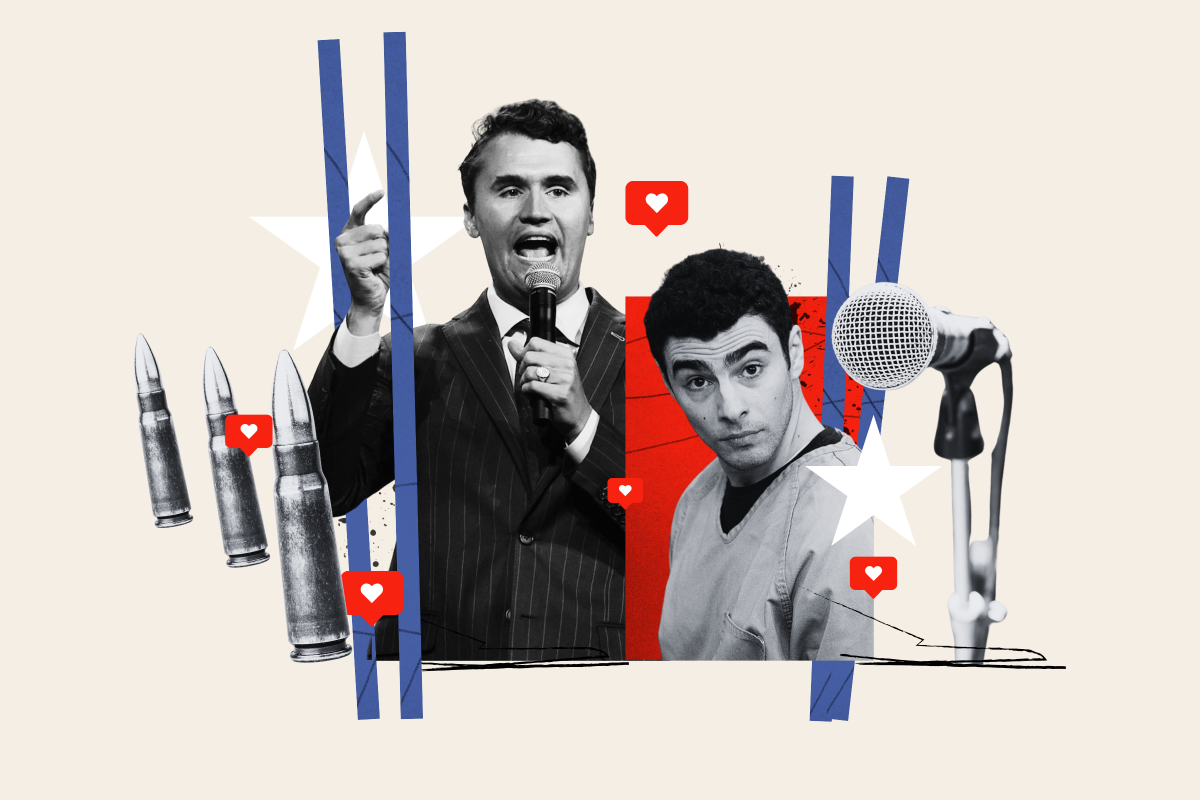
Jason Kingsley remembers exactly where he was when the Sniper Elite team first started talking about testicles.
I’m midway through a conversation with the Rebellion Developments studio head, who is giving me the full history of Sniper Elite, the ultraviolent shooter series that kicked off 20 years ago. He’s deep in thought, explaining the origins of the series’ signature killcam, a feature that allows you to see your bullet cut through its victims bones and organs in a graphic X-ray.
“We were talking about human anatomy and organs,” Kingsley tells Polygon in a video interview over Zoom. “We’d modeled all of them and the senior producer came up to me and said, ‘This is going to be a weird question … Do we do testicles?’ And you could see everybody in the surrounding area just went silent. Half the office went silent. And I went, ‘We have to.’”
That willingness to go all-in is what has helped turn Sniper Elite into a shooter institution for 20 years. It may not be a sales juggernaut on the scale of Call of Duty, but recent installments like Sniper Elite: Resistance continue to draw a dedicated community, all while doubling down on the series’ compact identity. In a conversation about Sniper Elite’s origins and future, Kingsley and lead level designer Beck Shaw broke down the fundamental ingredients that have allowed them to create a consistent, long-lasting series.
Though the team has pride in the series’ past, there’s a sense they are struggling to fully place it in a politically charged present that has recontextualized the meaning of a World War II game about gunning down Nazis. During our conversation, the duo maintained that they’re interested in playing with history rather than connecting it to the current political climate the series is built in.
“We just want to make a fun, entertaining game that distracts people,” Kingsley said.
Sniper Elite debuted in 2005, launching during the height of gaming’s World War II craze shaped by shooters like Medal of Honor. Coming off of creating games like Aliens Versus Predator in the late ‘90s, Jason and his brother Chris Kingsley looked to Call of Duty as a source of inspiration to create a more historically grounded shooter about a real war.
“[Chris] was really interested in the fact that the allies had teams of engineers going around Germany sometimes ahead of the front line, and they were stealing equipment,” Kingsley says. “So basically you had this Kelly’s Heroes sort of situation of engineers stealing fabrication plants from the Germans to take them back. Western Europe was pretty much on its last legs. Everything had been destroyed and taken apart more or less. The economies were all completely shot to shit. Everybody was desperately trying to finish the war, but lots of people were planning for what happened after the war as well. And so we felt that was incredibly fertile as an environment for a game.”
That was a strong backdrop for a game, but the challenge would be finding a way to do something different with the shooter genre in a 2005 landscape packed with Call of Duty 2, Battlefield 2, Medal of Honor: European Assault, Brothers in Arms: Road to Hill 30, Vietcong 2, and more. That’s when they started looking down the sniper scope.
“Me and Chris were looking at areas of games that were less used and we suddenly realized that lots of people really liked sniping, but it was sort of frowned upon,” Kingsley says. “It was camping and it was sort of against the rules and we thought, you know what? Lots of people actually like that. I wonder if we could make a game to focus very much on that mechanic there and slow it down a bit.”
While sniping games existed at that point, Silent Scope being the most notable example, it was a novel enough concept to let Rebellion toy around with a different kind of shooter — even if it would require them to take a lot of creative liberties to make a fun shooter hook.
“We can’t make people sit there for three days just holding the controller for three days and nothing happens and then the target doesn’t turn up and then they have to go home,” Kingsley jokes.
In an attempt to make sniping more exciting than its slow reality, Jason and Chris began thinking about how a shot should feel. The nature of the weapon meant that players couldn’t just thoughtlessly mow down waves of Nazis. Each bullet would have to matter, carrying real weight.
“In the very beginning, we wanted to move away from that sort of A-Team, TV show, shoot-machine-guns-at-people-and-nothing-happens-to-them [feel],” Kingsley says. “We wanted to lean into the fact that a bullet can do terrible things to a human body. A single bullet can kill somebody and it’s horrible. So we shouldn’t celebrate it. Sometimes it’s necessary. Sometimes they’re baddies, sometimes they’re enemies. There are rules about that kind of stuff. And as horrible as it is, war happens. What we wanted to do is challenge people to take almost as few shots as they need to do in one level … How do we get you to almost feel a bit guilty potentially about actually shooting somebody even though you have to?”
That thinking led to Sniper Elite’s defining feature: its killcam. Whenever you land a successful snipe in the series, the camera locks in on the bullet as it travels to its target in slow motion. As the lead hits them, the enemy’s body is shown in an X-ray view. You see the bullet shatter their bones, tear through an eye socket, and, yes, even blast apart a Nazi’s testicles. It’s gruesome, sickly, cathartic, and very controversial.
The Sniper Elite series’ age means that it has lived through several debates about violent video games and their influence on real world violence. (That conversation is back in the headlines after conservative content creator Charlie Kirk was shot and killed at an event at Utah Valley University, midway through downplaying America’s gun violence epidemic.) Turn the clock back to March 8, 2018, when then-first-term president Donald Trump held a meeting to discuss video game violence. A reel of bloody video game sequences was shown during the meeting, with several clips showing players mutilating digital Nazis. Sniper Elite was front and center in the video, in a moment where a bullet blows through an enemy soldier’s skull, shattering it into pieces.
The Trump administration’s use of the clip is ironic considering that the Kingsleys thought of the killcam as a way to show the true impact of wartime violence, not sugar-coating the devastation a gun can cause. The series would even go through great lengths to put the personal back into video game violence, with sequels letting players look at their victims’ biographies. Has Sniper Elite’s love of hyperviolence been misinterpreted by pearl-clutching politicians for two decades? Kingsley is fine with people seeing his studio’s work as depraved.
“I don’t think any interpretation is wrong,” Kingsley says. “It’s a form of the creative arts in a way, a computer game. Therefore, if you’re going to be all academic about it, art is in the eye of the beholder. So what does the bullet cam mean to you, the viewer? That will depend perhaps on whether you come from a culture where guns are front and center like the US or whether you come from a culture perhaps like the UK where quite frankly hardly anybody uses guns at all … My feeling is that the killcam is a reward for the player and a payoff for making a good shot, but it’s also meant to make them reflect on what it is they’re actually doing. Other people may just look at it and go, this is a great gory event and I really enjoy seeing horrible things like that.”
The games industry doesn’t really have that sort of critical analysis in the same way that other forms of media do.
While Kingsley says he welcomes all interpretations of Sniper Elite, his attitude is a bit different when I ask him about the series’ place amid a rise in political violence and cries of American fascism. I point out that in the 20 years since the series has been around, the public perception of Nazis has transformed from a fading piece of World War II history to a resurgence in white nationalism. Kingsley agrees that Nazis are at least talked about more in contemporary politics these days. When I ask if that shifting context has changed the way they approach the series, both Kingsley and Shaw maintain that their focus on history isn’t in conversation with contemporary politics.
“World War II is its own thing. It’s in the past,” Kingsley says. “The baddies are very bad. We are the goodies and we’ve got to take the baddies out. And I think that’s very simplified. If you start to go into more modern interpretations and more modern overlays, it can get very complicated, very muddy. And yes, certain types of media can deal with that. Films and books can deal with the complexities of that. I don’t think we’d want to deal with it in our game at all. It’s irrelevant to us to a certain extent.”
“The team firmly sees it in World War II. It’s in the past, it’s in that time period, and I think that’s probably where we’ll stay for the foreseeable,” Shaw echoes.
It’s a very different philosophy compared to some of Sniper Elite’s contemporaries. Wolfenstein developer MachineGames, for instance, has not been shy about connecting its fictional fascism to today’s world. When promoting Wolfenstein 2: The New Colossus in 2017, during President Donald Trump’s first term, the studio used slogans like “Make America Nazi-Free Again” to promote the shooter. Even if the Wolfenstein games delve into pure sci-fi fantasy, there’s a sense that the developers are interested in telling stories about Nazi carnage for a reason. Kingsley, on the other hand, paints Sniper Elite as a simulation of a violent bygone era.
He isn’t shy in discussing how other real-world politics can create perspective in gamemaking, though. When we were talking about how the team embraced the limitations that a World War II game presents, he points to Russia’s current war in Ukraine as something he believes will inform the way future shooters are made.
“For us in a game like Sniper Elite, it was fairly mechanical,” Kingsley said. “You had radios, but they were heavy. You didn’t have drones, you didn’t have satellites, you didn’t have all that kind of complex stuff. You had men and guns. That lends itself to a very simplified form of gameplay. I mean, just look at what’s happening in Ukraine at the moment. The nature of warfare is changing radically, and I would guess in 10 years time, the nature of shooters will probably reflect the reality on the ground more in Ukraine because it’s absorbed into the brains of people growing up who are new game designers.”
The pushback against the idea that the developers of Sniper Elite, a game about killing Nazis, would naturally be informed by the world in which the developers currently live in doesn’t seem entirely consistent with Kingsley’s thinking at first. It’s not a matter of a studio head just trying not to alienate a swath of its playerbase, either. In an earlier part of the conversation, Kingsley says that Rebellion doesn’t care for market research and is comfortable alienating players to cater to a focused audience. As we dig into his philosophy further, he comes back around to welcoming modern-day interpretations — he’s more just skeptical that gaming is a medium for that kind of thought at all.
“I am very cautious about telling people how they should interpret our work,” Kingsley says. “We put it out there, we have an interpretation, we have a way of looking at it. Other people’s interpretation of it through their own lens isn’t right or wrong; it’s their interpretation of it. And one might then have a conversation with them about what it means, and we might end up getting quite animated about what we meant and how they interpreted it and that kind of stuff. But the games industry doesn’t really have that sort of critical analysis in the same way that other forms of media do, perhaps.”
In earnest, he asks me if I agree with that interpretation. I tell him that I don’t. There has always been critical analysis of games, and that work is still being done today. He chews on that, recalling his experience studying literature back at university. He tells me about talking to a student who wondered why the curtains described in a book were blue. Kingsley rejected the idea that there was any symbolism there, positing that the author probably chose blue to “get the damn book finished.”
We eventually move on to talk about the future of Sniper Elite. Kingsley and Shaw tell me about how they want to stay committed to what the series does well instead of turning it into something different. They joke about doing a crossover event with Rebellion’s latest game Atomfall, sending Sniper Elite’s Karl Fairburne to that game’s British dystopia. (“Quite an interesting idea, actually. We’ll have to think about that,” Kingsley says, seeming to have a genuine revelation in the middle of a joke.)
But the moment that sticks with me when we talk about the future is even more hypothetical. As we tie off our friendly debate about whether or not games can communicate anything substantial and be analyzed in the same vein as literature, Kingsley seems to have a moment of clarity about what the series’ actual legacy might be in another two decades — that, perhaps, a growing wave of intellectually curious players will fill in their own interpretations.
“It’s going to be interesting for us as professionals in games that maybe start to get analyzed in 20 years time in university courses. And people are sort of writing PhD thesis on the meaning behind the Sniper Elite killcam,” Kingsley says. “That’s a good idea! And whether it actually resembles anything we were thinking of at the time, in fact or not … I don’t know!”



